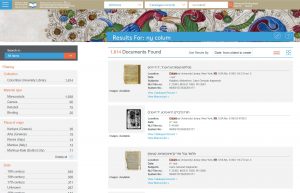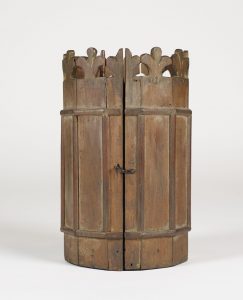At Columbia University Libraries, and at the Norman E. Alexander Library in particular, one of our major goals is to provide access to materials to as broad a user base as possible. With one of the largest Judaica manuscript collections in the United States, a major priority has been to provide access to these unique materials – through partnership with the National Library of Israel’s KTIV Database of Hebrew Manuscripts; through digitization of microfilm for hundreds of manuscripts, and, bit by bit, through internal digitization of those manuscripts that have not been made available in any other way.
But digitizing manuscripts is no simple task. Each manuscript must be carefully assessed and sometimes requires conservation before it can be imaged. The image process itself is complex, requiring talented professionals shooting the manuscripts safely, checking each image to ensure it is up to CUL’s high standards, and archiving the images for safe future use before posting them online. In this post, we’ll spend some time describing the complicated processes required to make the Alexander Library’s manuscripts available to the world.

In 2021, the Alexander Library received a remarkable financial gift from an anonymous donor. There were no stipulations to the gift, other than that it be used for the Alexander library. This is the best (although probably the rarest) kind of donation, which shows the donor’s confidence in those managing the library to make the best decisions for the collection. Additionally, it allowed for “behind the scenes” work, which is often quite costly but not generally obvious to the general public. The gift would be used for multiple purposes: conservation, processing, and digitization. A sample survey in the early 2000s of the Judaica collection had noted that quite a few manuscripts required serious conservation. This collection, which had been formed alongside the University itself, did not have a curator to care specifically for it until the generosity of the Norman E. Alexander family created a position for a librarian in 2008. The anonymous donation would thus go a long way toward supporting collection care. Three items that were so badly damaged that they could not be used at all (a 13th century volume of Midrash on Genesis, a 17th century volume of Talmudic commentaries, and a 17th century dispute regarding a building in Italy that blocked light from an orphanage) were shipped off to the Center for Conservation of Art and Historic Artifacts in Philadelphia. The donor’s gift thus allowed the Libraries to supplement existing in-house capabilities by sending the manuscripts to this external facility where they could be safely conserved and returned to Columbia ready to be digitized and, later, re-bound.
Funds were also used to purchase conservation-grade boxes for many of the manuscripts in the collection that needed better housing, and also funded the work of students (Hannah Vorschheimer, Elisheva Malomet, and Relly Robinson) to process and upload manuscript images digitized from microfilm to the Internet Archive site for Columbia’s Judaica manuscripts.
The most time-intensive project, however, was the planned digitization of about 130 manuscripts which were not otherwise accessible in any way. The project involved multiple
departments and workflows. Before digitization could begin, we needed to ensure that the manuscripts were cataloged. While the vast majority of the collection had been cataloged into CLIO through a major project from 2008-2010, there were still a few dozen manuscripts that did not have catalog records. Rare book cataloger Matthew Haugen stepped in to create the relevant catalog records. Additionally, some codices contained multiple texts bound together, and so these had multiple catalog records – one for each text. In order to have the correct metadata assigned to a single physical unit, Matthew also combined information for multiple records into a single record for each item.
The manuscripts then had to be reviewed by the Libraries’ Conservation department – Alexis Hagadorn, Morgan Adams, and Emily Lynch reviewed each manuscript to see if it had any needs before it could be safely imaged. In some cases, conservation work was necessary prior to digitization, and thankfully the generous gift allowed us to do this work. In other cases, manuscripts were deemed too delicate to digitize, or they were flagged as needing critical conservation that would cost far more time and money than we had to work with at the time. These were removed from the digitization queue and flagged for a later conservation project. Sometimes the conservators approved digitization, but with special handling such as with specialized equipment or supports to keep the manuscripts safe during imaging. The review brought the total number of manuscripts to be digitized down to about 100, but and set important future conservation priority needs. In some cases, the decision was made to shoot just a sample image of a manuscript, such as the Megilat Esther above, or the Torah scroll below, since these texts are not unique, but the physical objects are of interest to scholars.
Each manuscript was pulled individually for imaging for Lauren Wansker, a Technical Assistant in the Preservation & Digital Conversion division of the Libraries. Enrique Ortiz imaged additional materials, including the Torah and Esther scrolls shown here. Dave Ortiz, Manager for the Digital Imaging Lab, supervised imaging work and advised the project team on approaches for different manuscripts, such as when special setups would be needed in the Lab. With careful precision, Lauren set up each manuscript according to specifications from the conservators, and photographed each page, one by one. Larger manuscripts required a special setup, as did single leaves or very small manuscripts. Following Lauren’s work, the quality control team of Andy Moore and Nancy Wolfe reviewed every single digitized image to make sure they met the department’s high standards of quality. In some cases, manuscripts included pages bound in upside down, so the team was careful to retain the images as they would look to one holding the physical book. Once the images passed QC, they were turned over to Yasuhito Denda – Yasu would crop the images to ensure that they’ll read like a book on the web, and then uploaded the images and all their associated metadata to the Internet Archive. Each digital book also received a new digital record so they can be found as new entities in CLIO. The entire project was ably overseen by Brianna Gormly, the Assistant Director of the Preservation, Reformatting, and Metadata department in the Libraries, whose close eye ensured that the entire project was executed seamlessly.
And what of those manuscripts that could not be digitized? What about new manuscripts, acquired after the digitization project had already begun?
This is to be our next project. Another gift from the same anonymous donor, along with a second gift from Haim Gottschalk, will be used to hire a conservator in Columbia’s lab over the 2023-2024 fiscal year to work on those manuscripts that were flagged as needing critical conservation work. Because conservation work is slow and careful, we cannot say exactly how many manuscripts will be conserved over the course of this coming year, but we will be prioritizing those with the most severe needs first. As more manuscripts are deemed safe for handling, we will work on planning our next digitization project to continue to make as much material as possible open to all users around the world.
If you’re interested in supporting these endeavors, you can donate to the Alexander Unrestricted fund by selecting it in the dropdown on the Libraries’ Gift page.



